Preliminary inner-marine salmon fishery proposals revealed but the marathon season-setting process is a long way from the finish line; ocean fisheries likely to see improvements Leave a reply
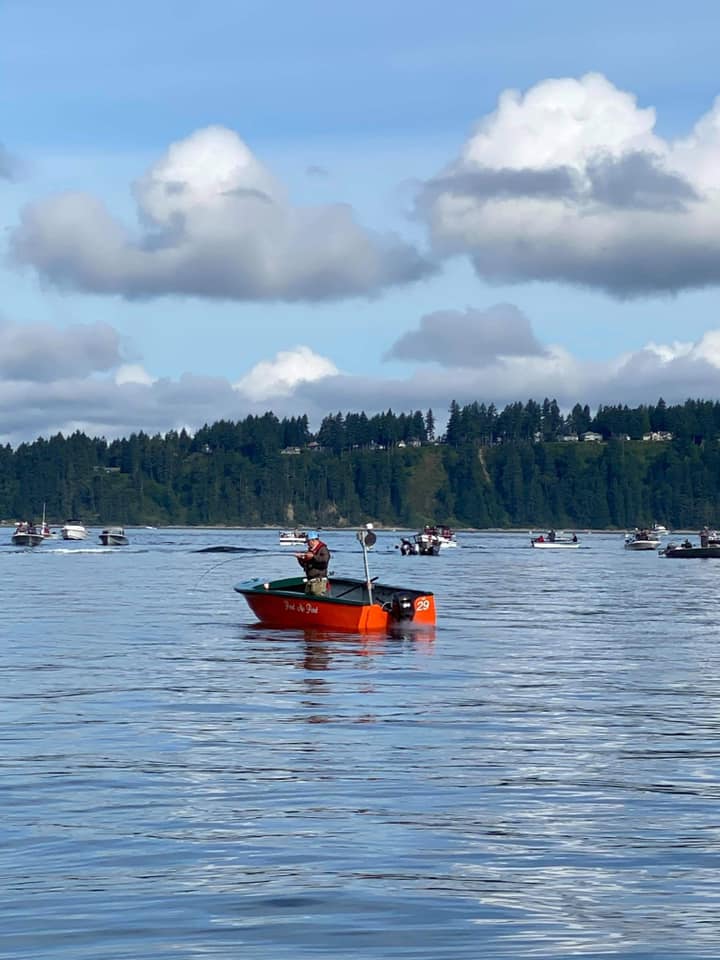
Contributed by Mark Yuasa, WDFW
The next stage of setting salmon fishing seasons began this week as the Washington Department of Fish and Wildlife (WDFW) unveiled the initial possibilities for the 2022-2023 inner-marine areas along with three ocean fishery alternatives.
While this is just the first lap around this marathon process, WDFW fishery managers unveiled preliminary scenarios of what sport-fishing seasons might look like in Puget Sound and Strait of Juan de Fuca this summer and fall.
The two early sport-fishing tables modeled with initial salmon forecasts and other factors were presented at the “North of Falcon 1” public meeting on Wednesday (March 16). Each showed marine sport fisheries mirroring the 2021-2022 fishing season with minor modifications. All the proposals are just beginning to take shape and will likely undergo many changes before any seasons are finalized by mid-April.
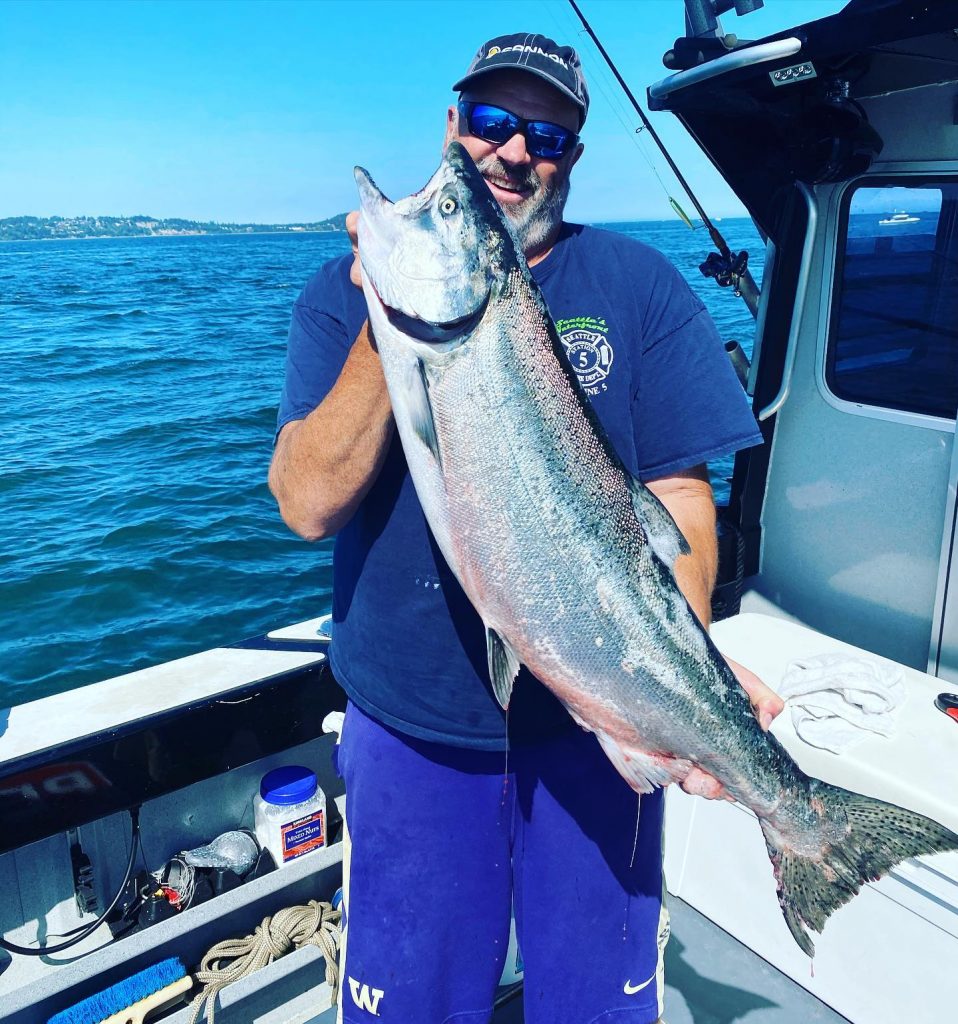
A few possibilities on the “wish list” include shifting back to a June 1 start in central Puget Sound (Marine Area 10) for a salmon fishery directed at resident coho; a later summer start time in the San Juan Islands (Area 7) for summer hatchery Chinook plus a chance to target a fairly good return of coho; and adding more winter Chinook to some areas although the latter would likely mean less summer opportunities. Another possible change from this past season would be eliminating the January and February Area 10 winter Chinook season and switching to a March only scenario.
What will collectively be speed bumps along the road in getting to the finish line in this arduous process are several stocks of concern. It is likely these lower salmon abundances will once again make the conversation around expanding sport fisheries hard during the 2022-2023 season.
In the Puget Sound region, salmon stocks of concern for Chinook point to Nisqually, Stillaguamish, and Snohomish systems. Sticking points for coho are the Puyallup, Snohomish, Strait of Juan de Fuca, and Hood Canal.
While Puget Sound wild Chinook have been an ongoing issue for a number of years, it looks like the overall 2022 forecast is up 6% compared to 2021 forecast but still 40% down from the 10-year average. The 2022 Puget Sound hatchery Chinook forecast is up 7% compared to 2021 forecast and 5% up compared to the 10-year average.
The 2022 Puget Sound-wide wild Chinook forecast is 28,992 (26,918 in 2021) and the hatchery forecast is 201,059 (202,185 in 2021).
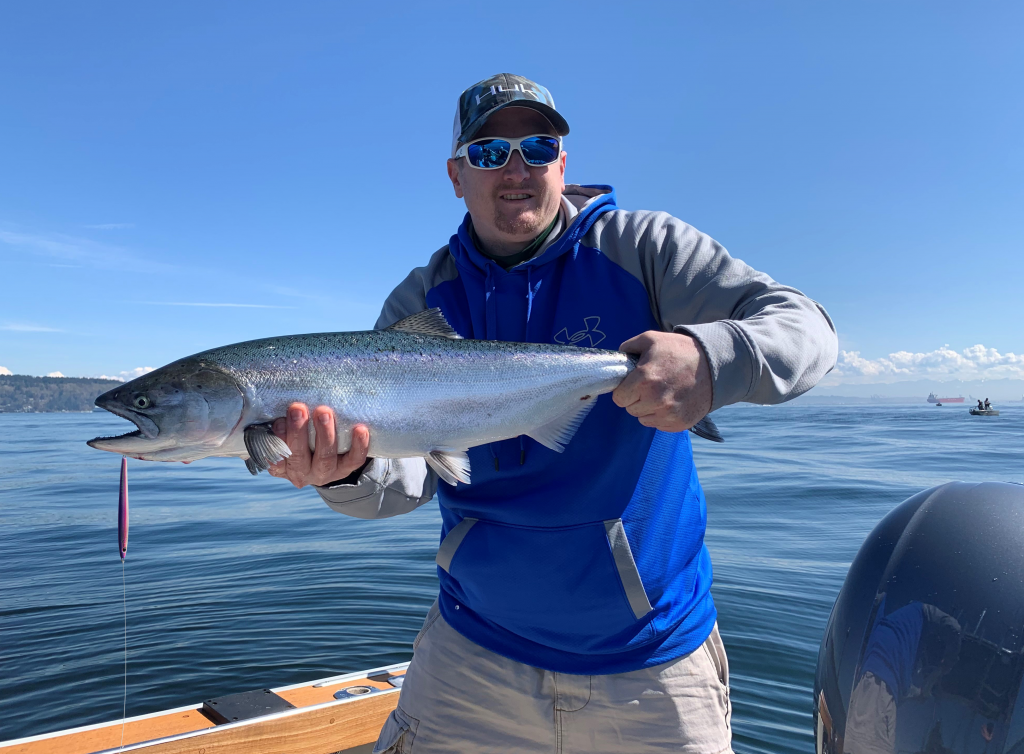
The Puget Sound-wide hatchery coho forecast shows an 8% improvement and wild coho are up 9% compared to 2021 forecast. The recent 10-year average for hatchery coho is up 61% and the wild coho is up 29%.
The combined Puget Sound hatchery and the wild coho forecast is 636,952 compared to 614,948 in 2021; 504,604 in 2020; 708,521 in 2019; and 557,149 in 2018. A dissection of predicted coho returnees, 387,722 are hatchery and 249,230 are wild (369,059 and 245,889 in 2021; 341,895 and 162,709 in 2020; 417,319 and 293,980 in 2019; and 307,975 and 249,174 in 2018).
Fishery managers will continue to keep tabs on wild coho returns to rivers such as the Snohomish, which remains in a rebuilding status after experiencing poor escapements in recent years.
The Snohomish wild coho spawning escapement goal is 55,000, and expects a 2022 forecast of 64,218 wild fish (60,000 in 2021) and 22,559 hatchery fish (29,938).
Positive ocean fishing alternatives
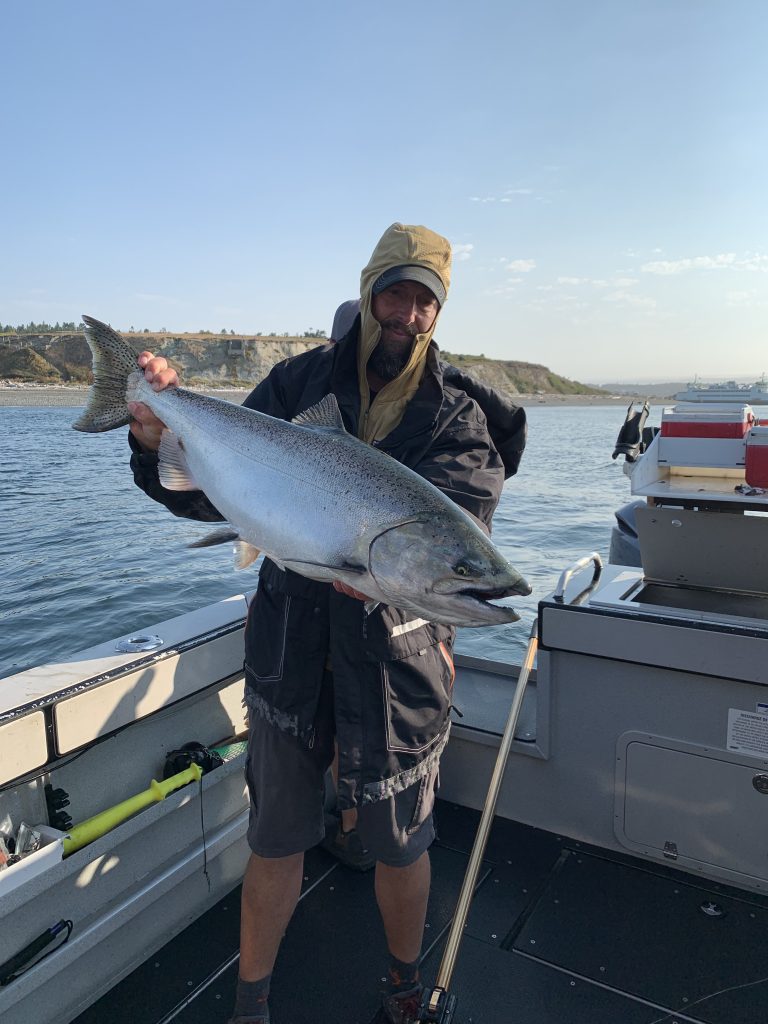
State, tribal, and federal fishery managers approved Monday (March 14) three ocean sport salmon alternatives during the Pacific Fishery Management Council (PFMC) meetings and will likely lead to a decent summer fishery off the coast and in the “Big-C” from Buoy 10 upstream this summer/fall.
This is due to a prediction of 484,900 fall Chinook in 2022 which is slightly higher than the 2021 actual return of 481,300 but below the forecast of 580,800.
The lower river “tule” hatchery Chinook (a driver for ocean salmon fisheries) is predicted at 73,000 (73,100 was the forecast and 74,700 was the actual return in 2021) and 89% of the 10-year average.
Coho are the star of the show in 2022, and this could be another banner year with a forecast in 2022 of 1,225,900 (1,732,900 was the forecast and 1,114,500 was the actual return in 2021). You’d need to look back to at least 2015 when the forecast was 1,015,000 to find anything closely resembling the 2022 forecast and 2021 actual return.
A key driver in limiting the ocean fisheries last year was the Queets River, which saw a poor return of 15,699 (11,780 were hatchery and 3,919 were wild), although much improved in 2022 and a forecasted return of 40,374 (22,214 are hatchery and 18,160 are wild) along with other coastal coho forecasts that shouldn’t be a hinderance.
Here are the three ocean fishing options set at the PFMC meeting:
ALTERNATIVE 1
Total Allowable Catch is 65,000 Chinook and 210,000 hatchery-marked coho quota (60,000 and 80,000 in 2021; 60,000 and 35,000 in 2020; 32,000 and 172,200 in 2019; and 58,600 and 37,800 in 2018).
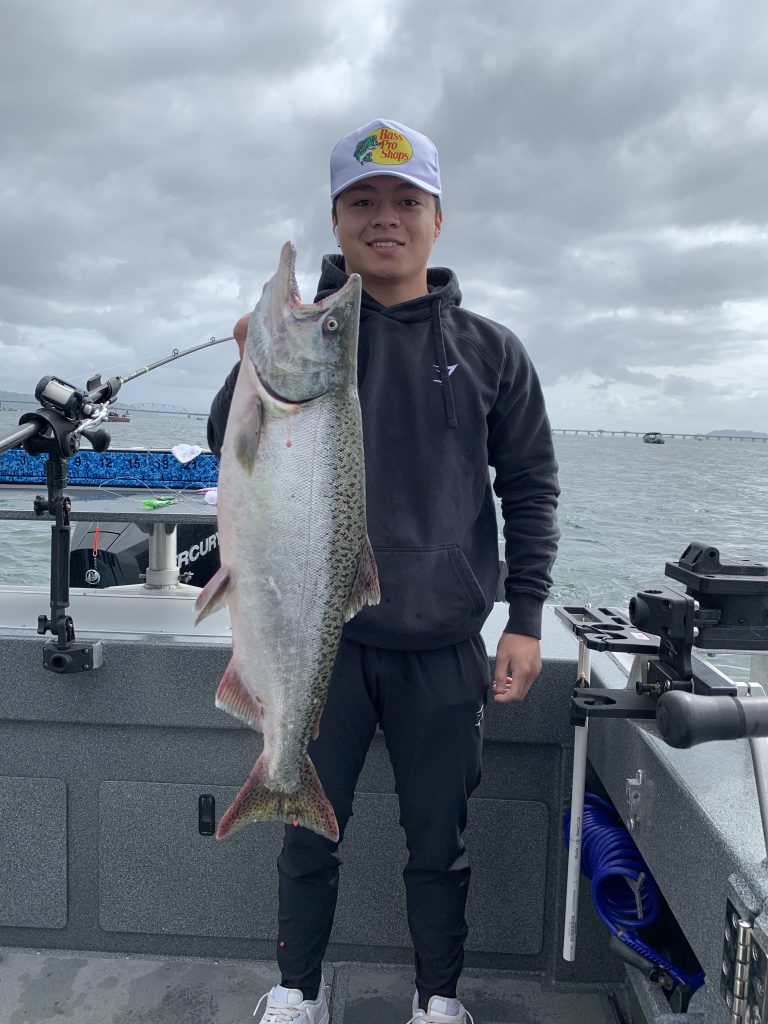
A breakdown of sport catch is 32,500 Chinook and 176,400 hatchery-marked coho quota (28,000 and 75,200 in 2021; and 30,000 and 29,400 in 2020).
(Other notes – No Area 4B add-on fishery. Buoy 10 fishery opens Aug. 1 with an expected kept catch of 45,000 hatchery-marked coho in August and September. Overall Chinook and/or coho TACs may need to be reduced or fisheries adjusted to meet NMFS ESA guidance, FMP requirements, upon conclusion of negotiations in the North of Falcon forum, or upon receipt of preseason catch and abundance expectations for Canadian and Alaskan fisheries.)
NEAH BAY: 7,350 Chinook and 18,350 hatchery-marked coho quota (6,000 and 7,820 in 2021; and 6,400 and 3,060 in 2020). Open daily from June 18 through Sept. 30 or could close sooner if quota is achieved. All salmon, except no chum beginning Aug. 1 with a two salmon daily limit; all coho retained must be hatchery-marked with missing adipose fin. Beginning Aug. 1, Chinook non-retention east of the Bonilla-Tatoosh line.
LA PUSH: 1,225 Chinook and 4,590 hatchery-marked coho quota (1,960 and 1,300 in 2021; and 1,250 and 760 in 2020). Open daily from June 18 through Sept. 30 or could close sooner if quota is achieved. Beginning June 18, all salmon, except no chum beginning Aug. 1 with a two salmon daily limit; all coho retained must be hatchery-marked with missing adipose fin. La Push Bubble Fishery open Oct. 1-9 with a 125 Chinook catch quota.
WESTPORT: 14,530 Chinook and 65,260 hatchery-marked coho (13,300 and 27,820 in 2021; and 14,200 and 10,880 in 2020). Open daily from June 18 through Sept. 30 or could close sooner if quota is achieved. Beginning June 18, all salmon with a two salmon daily limit and no more than one may be a Chinook, Chinook minimum size is 22 inches; all coho retained must be hatchery-marked with missing adipose fin.
ILWACO: 9,270 Chinook and 88,200 hatchery-marked coho (7,400 and 37,600 in 2021; and 8,000 and 14,700 in 2020). Open daily from June 18 through September 30, all salmon with a two salmon daily limit and no more than one may be a Chinook, Chinook minimum size is 22 inches; all coho retained must be hatchery-marked with missing adipose fin.
ALTERNATIVE 2
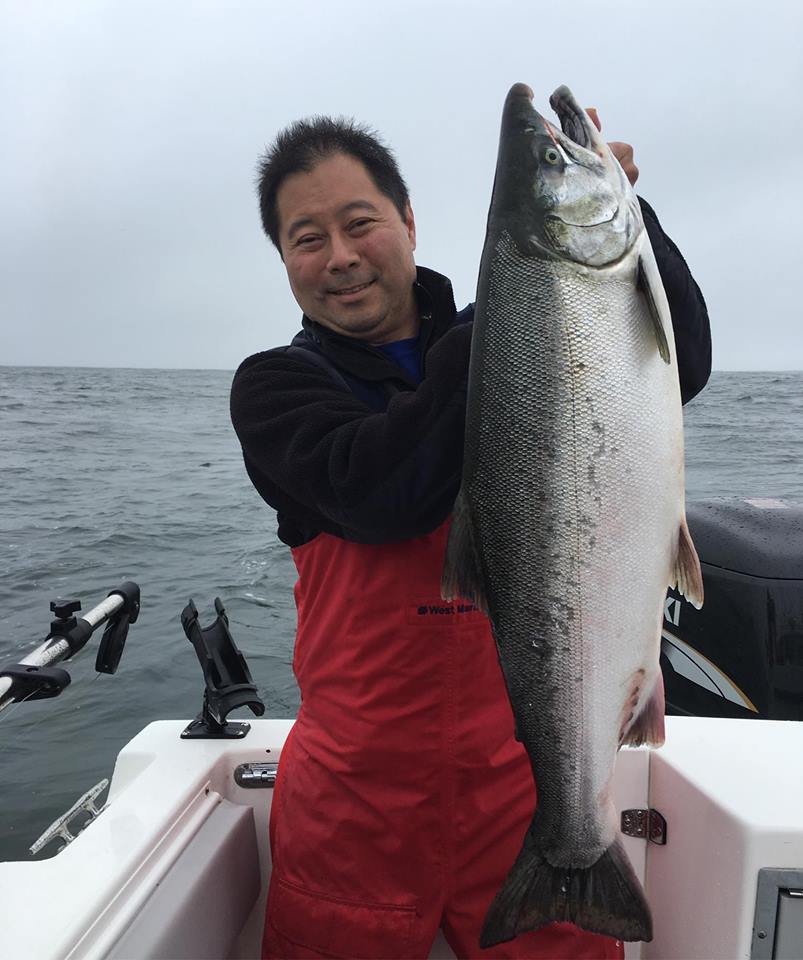
Total Allowable Catch is 60,000 Chinook and 185,000 hatchery-marked coho (50,000 and 110,000 in 2021; 45,000 and 25,000 in 2020; 27,500 and 159,600 in 2019; and 30,000 and 14,700 in 2018).
A breakdown of sport catch quota is 30,000 Chinook and 155,400 hatchery-marked coho (25,000 and 95,600 in 2021; and 22,125 and 22,500 in 2020).
(Other notes – Same as Alternative 1. Buoy 10 fishery opens Aug. 1 with an expected kept catch of 55,000 hatchery-marked coho in August and September. Overall Chinook and/or coho TACs may need to be reduced or fisheries adjusted to meet NMFS ESA guidance, FMP requirements, upon conclusion of negotiations in the North of Falcon forum, or upon receipt of preseason catch and abundance expectations for Canadian and Alaskan fisheries.)
NEAH BAY: 6,000 Chinook and 13,980 hatchery-marked coho (6,000 and 16,160 in 2021; 5,400 and 7,860 in 2021; and 4,700 and 2,340 in 2020). Open daily from June 25 through September 30, except no chum beginning Aug. 1 with a two salmon daily limit; all coho retained must be hatchery-marked with missing adipose fin. Beginning Aug. 1, Chinook non-retention east of the Bonilla-Tatoosh line.
LA PUSH: 1,240 Chinook and 4,040 hatchery-marked coho (1,200 and 1,970 in 2021; and 1,100 and 580 in 2020). Open daily from June 25 through September 30, all salmon, except no chum beginning Aug. 1 with a two salmon daily limit; all coho retained must be hatchery-marked with missing adipose fin.
WESTPORT: 13,410 Chinook and 57,500 hatchery-marked coho (11,800 and 27,970 in 2021; and 10,500 and 8,330 in 2020). Open daily from June 25 through September 30 or could close sooner if quota is achieved. All salmon with a two salmon daily limit and no more than one may be a Chinook, Chinook minimum size is 22 inches; all coho retained must be hatchery-marked with missing adipose fin.
ILWACO: 8,560 Chinook and 77,700 hatchery-marked coho (6,600 and 57,800 in 2021; and 5,800 and 11,250 in 2020). Open daily from June 25 through September 30 or could close sooner if quota is achieved. All salmon with a two salmon daily limit and no more than one may be a Chinook, Chinook minimum size is 22 inches; all coho retained must be hatchery-marked with missing adipose fin.
ALTERNATIVE 3
Total Allowable Catch is 53,000 Chinook and 160,000 hatchery-marked coho (all fisheries off entire coast closed in 2021 and 2020; 22,500 and 94,400 in 2019; and all fisheries off the entire coast closed in 2018).
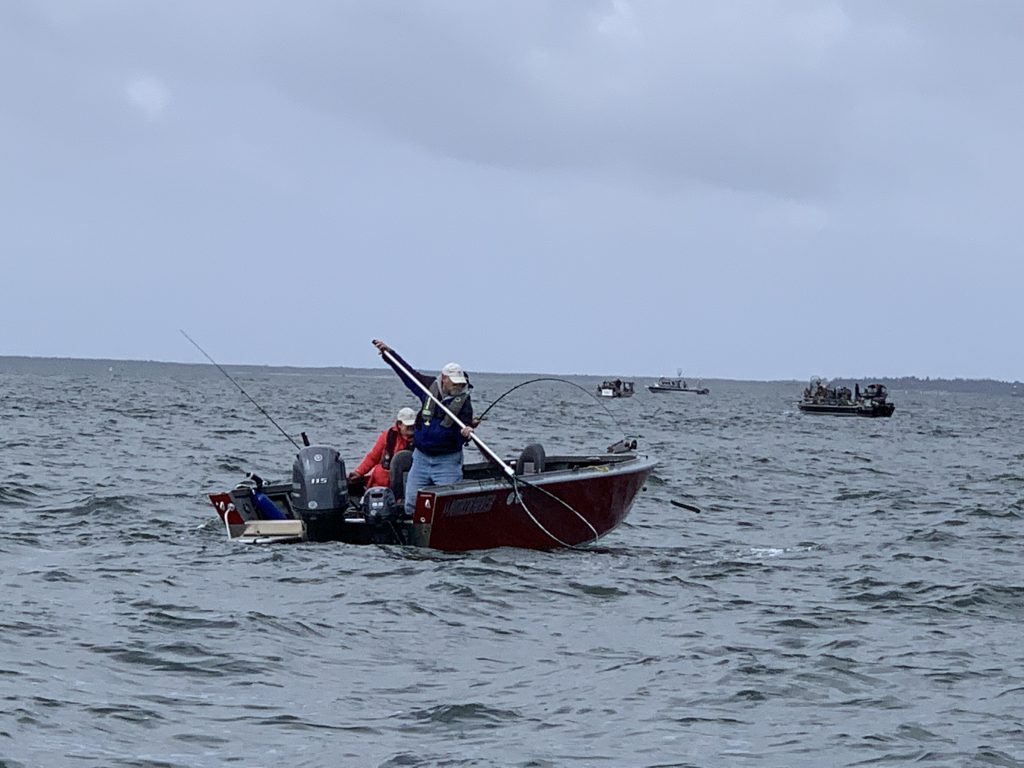
A breakdown of sport catch quota is 26,500 Chinook and 134,400 hatchery-marked coho.
(Other notes – Same as Alternative 1. Buoy 10 fishery opens Aug. 1 with an expected kept catch of 65,000 hatchery-marked coho in August and September. Overall Chinook and/or coho TACs may need to be reduced or fisheries adjusted to meet NMFS ESA guidance, FMP requirements, upon conclusion of negotiations in the North of Falcon forum, or upon receipt of preseason catch and abundance expectations for Canadian and Alaskan fisheries.)
NEAH BAY: 6,790 Chinook and 16,160 hatchery-marked coho (5,400 and 7,860 in 2021; and 4,700 and 2,340 in 2020). Open daily from June 18 through September 18, all salmon, except no chum beginning Aug. 1 with a two salmon daily limit; all coho retained must be hatchery-marked with missing adipose fin. Beginning Aug. 1, Chinook non-retention east of the Bonilla-Tatoosh line.
LA PUSH: 1,100 Chinook and 3,490 hatchery-marked coho (1,200 and 1,970 in 2021; and 1,100 and 580 in 2020). Open daily June 18 through September 18, all salmon, except no chum beginning Aug. 1 with a two salmon daily limit; all coho retained must be hatchery-marked with missing adipose fin.
WESTPORT: 11,840 Chinook and 49,730 hatchery-marked coho (11,800 and 27,970 in 2021; and 10,500 and 8,330 in 2020). Open Sundays through Thursdays only from June 26 through September 18 or could close sooner if quota is achieved. All salmon with a two salmon daily limit and no more than one may be a Chinook, Chinook minimum size is 22 inches; all coho retained must be hatchery-marked with missing adipose fin.
ILWACO: 7,560 Chinook and 67,200 hatchery-marked coho (6,600 and 57,800 in 2021; and 5,800 and 11,250 in 2020). Open daily from June 26 through September 18 or could close sooner if quota is achieved. All salmon with a two salmon daily limit and no more than one may be a Chinook, Chinook minimum size is 22 inches; all coho retained must be hatchery-marked with missing adipose fin.
Other salmon news
The Puget Sound/Hood Canal fall chum return are still coming out of a deep hole and the 2022 hatchery component is down 49% and the wild is down 40% compared to the 10-year average.
In general, chum returns are improved over the 2019 and 2020 forecasts, but they pale in comparison from 2013 to 2018 when the combined forecasts were close to or above 1.5-million mark.
The 2022 fall wild and hatchery chum prediction is 723,611 (525,604 in 2021; 874,307 in 2020; and 1,035,835 in 2019). In Hood Canal the chum forecast is 306,488 (273,396, 471,810 and 518,645) and southern Puget Sound is 189,460 (121,078, 309,573 and 263,171).
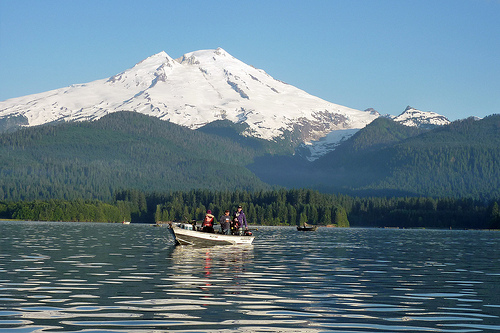
The Lake Washington sockeye numbers continue to struggle with an 86% decline and the Bake Lake prediction remains neutral compared to the 10-year average.
The Lake Washington sockeye numbers could hit an all-time low with a 2022 forecast of 10,165 (24,807 in 2021; 20,166 in 2020 and 15,153 in 2019).
The Lake Washington sockeye spawning escapement goal is 350,000 before any fisheries can be considered. The last time it was open for sport fishing was 2006 when 453,543 returned. Since then, the run dipped dramatically to 25,123 in 2018 and 22,165 in 2009, but had 100,000-plus returns in 2017, 2013, 2012 and 2010.
Despite ramped up hatchery production at the Cedar River’s Landsburg Hatchery facility to mitigate the loss of sockeye, state, and tribal fishery biologists in 2021 looked for alternative ways to help boost recovery that included capturing and transporting fish from the Ballard Locks to the hatchery. A return of more than 38,000 in 2021 was the most since 2017.
Early indications by WDFW show this by-pass is a proven success and only time will tell. For many years, sockeye have been taken from the fish weir at the Cedar River mouth and transported directly to the hatchery to boost survival too.
There’s a myriad of barriers sockeye need to deal with from smolt predation in the lake by cutthroat trout, bass, yellow perch and northern pikeminnows as well as increased pre-spawn mortality rates, and extremely warm water, disease and low dissolved oxygen levels in the Lake Union Ship Canal and Lake Washington.
On paper, the 2022 Baker Lake sockeye forecast appears improved at 27,081 (12,253 in 2021; 13,242 in 2020; and 33,737 in 2019). If the run comes in as forecast it should generate some summer fishing in the lake itself, although any fishery in the Skagit River remains up in the air.
Upcoming salmon meetings
March 21, 6-8 p.m., Grays Harbor fisheries discussion. March 23, 6-8 p.m., North Coast, Strait of Juan de Fuca, and Hood Canal discussion. March 24, 6-8 p.m., Willapa Bay fisheries discussion. March 28, 6-8 p.m., Puget Sound and freshwater sport discussion. March 30, 9 a.m.-12 p.m., the WDFW North of Falcon (NOF) public meeting is a follow up to discuss fisheries in Puget Sound, Strait of Juan de Fuca, Willapa Bay, Grays Harbor and ocean areas north of Oregon; and April 6-13, the PFMC meeting will adopt final salmon fishing seasons at the DoubleTree by Hilton Hotel at Sea-Tac . NOTE: The final April meeting will not be open to the public and all other meetings will be via Zoom only. For a complete list of other regional meetings, go to the WDFW website.
(Mark Yuasa is a Washington Department of Fish and Wildlife Communications Consultant and longtime contributor to ESPN 710 KIRO The Outdoor Line. He also was the fishing and hunting reporter at The Seattle Times for 28 years.)

